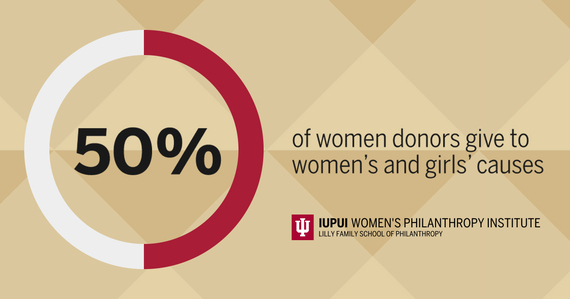Sara Blakely, founder & CEO of Spanx, proclaimed in her Giving Pledge letter, "I am committed to the belief that we would all be in a much better place if half the human race (women) were empowered to prosper, invent, be educated, start their own businesses, run for office-essentially be given the chance to soar! I pledge to invest in women because I believe it offers one of the greatest returns on investment."
With these powerful words, Blakley galvanized a top spot on the list of global leaders in philanthropy. Not only did she give us shapewear for every season, but she also declared as truth what so many women across the globe know intuitively but don't have a megaphone to champion: When we donate to nonprofit organizations that lift up women, we can be assured that our philanthropic investments will generate dividends for entire communities.

And now, as a result of new research from the Women's Philanthropy Institute at the Indiana University Lilly Family School of Philanthropy, we have empirical evidence to better understand why women invest in women. This research also offers inspiration for emerging and seasoned philanthropists alike with examples of compelling projects that are moving the meter for women and girls, both in the United States and around the world.
The research, Giving to Women and Girls: Who Gives and Why, is the first empirical study to systematically analyze this trend among individual donors. The findings show that nearly 50 percent of female donors support causes for women and girls and -- noteworthy -- 40 percent of male donors also support these causes. Increasing age and income levels are the most likely determinants of giving to women's and girls' causes; other control variables do not affect giving to a similar extent.

It is as important to understand who gives to various philanthropic causes as it is to understand what motivates and discourages these donors. To this end, three research findings from Giving to Women and Girls: Who Gives and Why are key:
- "Women are more likely to give to women's and girls' causes, give larger amounts to these causes, and are more likely to report giving to domestic violence organizations, women's centers, LGBT rights, cancer care and research, and economic opportunities for women and girls.
Women report giving to women's and girls' causes based on their personal experiences, including experiencing discrimination and having children, and because they believe giving to women and girls provides the best social return. Barriers to giving to women's and girls' causes include the complexity and scalability of women's issues, the sex-segregated nature of women's giving, and the connection to political issues which are often embedded in women's causes."One need not look far to see these research findings come to life in game-changing grants in support of women and girls. The Bill & Melinda Gates Foundation
and help accelerate progress for women and girls globally. Also this spring, Jennifer and Peter Buffett of the NoVo Foundation
in the United States. Last November, 28 women's funds from across the nation collaborated to launch
a $100 million effort that focuses on economic security for low-income women and their families.
Women now control 30 percent of global wealth, around $39.6 trillion -- up from 25 percent held five years ago. Female entrepreneurs in the United States accounted for 36 percent of all businesses in 2012 and those numbers continue to rise. What's more, as women's wealth and business ownership increase, as well as women's inheritance from parents and spouses, so does women's giving -- individually and collectively.
The women -- and men -- who are doubling down on their philanthropic investments in nonprofits that lift up women have high hopes that these investments will lead to healthier families, communities and nations across the globe. With stakes this high, this research suggests a path for all of us to follow -- a path toward a world in which both boys and girls may live to their fullest potential.
Support HuffPost
Our 2024 Coverage Needs You
Your Loyalty Means The World To Us
At HuffPost, we believe that everyone needs high-quality journalism, but we understand that not everyone can afford to pay for expensive news subscriptions. That is why we are committed to providing deeply reported, carefully fact-checked news that is freely accessible to everyone.
Whether you come to HuffPost for updates on the 2024 presidential race, hard-hitting investigations into critical issues facing our country today, or trending stories that make you laugh, we appreciate you. The truth is, news costs money to produce, and we are proud that we have never put our stories behind an expensive paywall.
Would you join us to help keep our stories free for all? Your contribution of as little as $2 will go a long way.
Can't afford to donate? Support HuffPost by creating a free account and log in while you read.
As Americans head to the polls in 2024, the very future of our country is at stake. At HuffPost, we believe that a free press is critical to creating well-informed voters. That's why our journalism is free for everyone, even though other newsrooms retreat behind expensive paywalls.
Our journalists will continue to cover the twists and turns during this historic presidential election. With your help, we'll bring you hard-hitting investigations, well-researched analysis and timely takes you can't find elsewhere. Reporting in this current political climate is a responsibility we do not take lightly, and we thank you for your support.
Contribute as little as $2 to keep our news free for all.
Can't afford to donate? Support HuffPost by creating a free account and log in while you read.
Dear HuffPost Reader
Thank you for your past contribution to HuffPost. We are sincerely grateful for readers like you who help us ensure that we can keep our journalism free for everyone.
The stakes are high this year, and our 2024 coverage could use continued support. Would you consider becoming a regular HuffPost contributor?
Dear HuffPost Reader
Thank you for your past contribution to HuffPost. We are sincerely grateful for readers like you who help us ensure that we can keep our journalism free for everyone.
The stakes are high this year, and our 2024 coverage could use continued support. If circumstances have changed since you last contributed, we hope you’ll consider contributing to HuffPost once more.
Already contributed? Log in to hide these messages.


